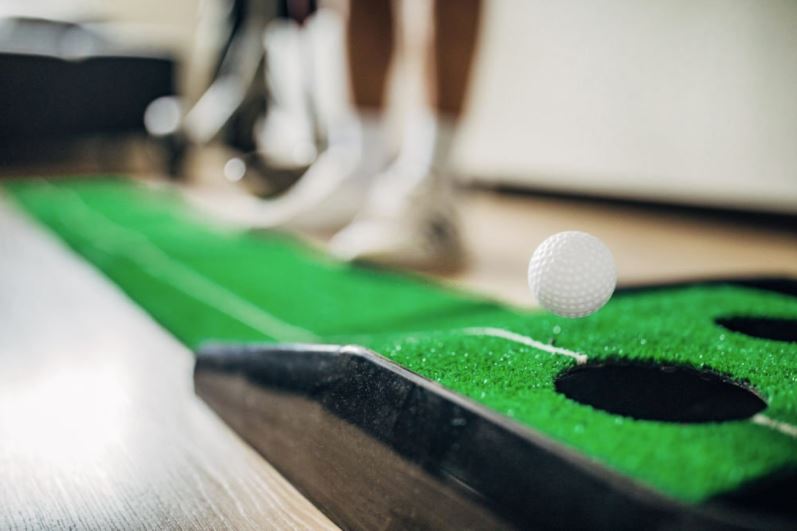Practicing golf swing at home has several benefits. Firstly, it saves time and money that you would otherwise spend at the golf course. Secondly, it allows you to practice consistently without worrying about the weather or course availability. Thirdly, it offers a comfortable and private space to focus on your swing without any distractions.
Setting up Your Home Practice Space
The first step to practicing golf swing at home is setting up a designated space. You can use your garage, backyard, or even a spare room in your house. The space should be large enough to accommodate your swing and equipment comfortably. It should also have a flat surface to ensure safety during practice.
Once you have identified the space, clear out any clutter, and ensure that the area is well-lit. You can also decorate the space with golf-themed posters or pictures to create a golfing atmosphere. Ensure that the space is well-ventilated to prevent any discomfort during practice.
Essential Equipment for Practicing Golf Swing at Home
To practice golf swing at home, you will need some essential equipment. These include a golf mat, golf net, golf balls, and golf clubs. A golf mat provides a stable surface to practice your swing, while a golf net ensures that the golf ball stays within the practice area.
When selecting golf clubs, choose the ones that suit your skill level and swing style. You can also invest in a golf simulator or launch monitor to analyze your swing and improve your accuracy.
Basic Golf Swing Technique
Before you start practicing, it’s essential to understand the basic golf swing technique. The golf swing consists of several components, including the setup, backswing, downswing, impact, and follow-through. Each component plays a significant role in ensuring a consistent and accurate swing.
During the setup, ensure that your feet are shoulder-width apart, and your weight is evenly distributed. When taking the backswing, keep your left arm straight and rotate your shoulders and hips. During the downswing, shift your weight to your left side and maintain a smooth and consistent motion.
During impact, ensure that your clubface is square to the ball, and your hands are ahead of the clubhead. Finally, during the follow-through, rotate your hips and shoulders and finish in a balanced position.
Drills to Improve Your Golf Swing at Home
Now that you understand the basic golf swing technique, it’s time to practice. There are several drills that you can perform to improve your golf swing at home. These include the towel drill, the swing path drill, and the weight shift drill.
The towel drill involves placing a towel under your arms and keeping it in place during your swing. This drill helps to promote a straighter and more compact swing. The swing path drill involves placing an object, such as a club or alignment stick, along your target line and ensuring that your swing follows the path.
The weight shift drill involves shifting your weight to your left side during the downswing and maintaining a balanced finish. These drills help to improve your swing mechanics and develop muscle memory.
Incorporating Fitness into Your Home Golf Swing Practice
Fitness plays a crucial role in golfing performance, and you can incorporate it into your home practice routine. You can perform stretches and exercises to improve your flexibility, strength, and endurance. Examples of such exercises include squats, lunges, and core exercises.
You can also use resistance bands or weights to add resistance to your exercises and improve your power. The key is to develop a fitness routine that complements your golf swing and suits your fitness level.
Analyzing Your Golf Swing at Home
Analyzing your golf swing is essential to identify areas that need improvement. You can use a golf simulator or launch monitor to analyze your swing speed, ball speed, and launch angle. These devices provide accurate and detailed information about your swing, allowing you to identify areas for improvement.
You can also record your swing using a smartphone or camera and analyze it in slow motion. This helps to identify any flaws in your swing and develop corrective measures.
Common Mistakes to Avoid When Practicing Golf Swing at Home
When practicing golf swing at home, there are several common mistakes that you should avoid. Firstly, avoid neglecting your fitness routine, as this can affect your swing performance. Secondly, avoid practicing in a cramped or cluttered space, as this can increase the risk of injury.
Thirdly, avoid neglecting the basic golf swing technique, as this can lead to inconsistent and inaccurate swings. Finally, avoid using worn-out or damaged equipment, as this can affect your swing performance and increase the risk of injury.
Conclusion
Practicing golf swing at home is an excellent way to improve your golfing skills and consistency. By setting up your practice space, investing in essential equipment, understanding the basic golf swing technique, and incorporating fitness into your routine, you can develop a consistent and accurate swing. Remember to analyze your swing regularly, avoid common mistakes, and utilize additional resources to enhance your practice experience. With consistent practice and dedication, you can improve your golfing performance and enjoy a more rewarding golfing experience.
